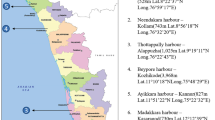Abstract
Parasitic copepods infestation on three species of commercially important fishes belonging to the family Mugilidae (Liza parsia) and Cichlidae (Oreochromis mossambicus and Etroplus suratensis) from Kayamkulam backwater were analysed between February 2015 and January 2017, covering all the three seasons. A total of 2305 fishes were analysed for parasites. Out of these, 299 fishes were infested with different species of parasitic copepods. The analysis revealed the presence of ten species of parasites comprising of Ergasilus parvitergam, Ergasilus sieboldi, Ergasilus sp, Caligus epidemicus, caligus sp, Dermoergasilus hoi, Dermoergasilus sp, Nothobomolochus sp, Lernea sp and Lepiophtherius sp. The infestation dynamics of parasitic copepods in terms of prevalence, mean intensity and mean abundance were calculated to determine the degree of infestation on each species. A higher prevalence (40%), mean intensity (13.2) and mean abundance (5.3) were found in Liza parsia while Etroplus suratensis had the lesser prevalence. There is a significant difference in the prevalence (p < 0.05), mean intensity (p < 0.05) and mean abundance (p < 0.01) in the rate of infestation of Liza parsia among the stations during the year 2015–2016, where as Oreochromis mossambicus and Etroplus suratensis shows no significant difference in the rate of infestation. The rate of infestation with parasitic copepod was higher in 2015–2016 than in 2016–2017. A higher proportion of fishes were more infested in Choolatheruvu (Station 3) as compared to Ayiramthengu (Station 1) and Valiyazheekal (Station 2).










Similar content being viewed by others
References
Boxshall GA, Halsey SH (2004) An introduction to copepod diversity. The Ray Society, London
Bush AO, Lafferty KD, Lotz JM, Shostak AW (1997) Parasitology meets ecology on its own terms. J Parasitol 83:575–583
Emily SP, Juliana RCM, Takemoto RM, Lima SE Jr (2018) Fish parasite diversity in the Amambai river, State Mato Grosso do Sul, Brazil. Acta Sci 40:1–7. https://doi.org/10.4025/actascibio/sci.v40i1.36330
Ho JS, Lin CL (2004) Sea lice of Taiwan (Copepoda: Siphonostomatoida: Caligidae). The Sueichan Press, Taiwan
Iyaji FO, Etim L, Eyo JE (2009) Parasite assemblages in fish hosts. Bio-Research 7(2):561–570
Kabata Z (1988) Copepoda and Branchiura. In: Margolis L, Kabata Z (eds) Guide to the parasites of fishes of Canada. Part II-Crustacea. Canadian Special Publication of Fisheries and Aquatic Sciences, Canada
Lacerda ACF, Roumbedakis K, Bereta JGS Jr, Nuner APO, Petrucio MM, Martins ML (2017) Fish parasites as indicators of organic pollution in southern Brazil. J Helminthol 92(3):322–331. https://doi.org/10.1017/s0022149x17000414
Lagrue C, Kelly DW, Hicks A, Poulin R (2011) Factors influencing infection patterns of trophically transmitted parasites among a fish community: host diet, host—parasite compatibility or both? J Fish Biol 79(2):466–485. https://doi.org/10.1111/j.1095-8649.2011.03041.x
Lester RJG, Hayward C (2006) Phylum Arthropoda. In: Woo PTK (ed) Fish diseases and disorders. Protozoan and Metazoan Infections, vol 1, 2nd edn. CABI, International, Cambridge
Margolis L, Esch GW, Holmes JC, Kuris AM, Schad GA (1982) The use of ecological terms in parasitology (Report of an ad hoc Committee of the American Society of Parasitologists). J Parasitol 68:31–133. https://doi.org/10.2307/3281335
Moller H (1987) Pollution and parasitism in the aquatic environment. J Parasitol 17(2):353–361. https://doi.org/10.1016/0020-7519(87)90110-x
Nike FA, Nestor GS, Emmanuel EB (2013) Copepoda parasites in economically important fish, Mugilidae (Mugil cephalus and Liza falcipinnis) from Lac Nokoue Lagoon in Republic of Benin, West Africa. Afr J Environ Sci Technol 7(8):799–807. https://doi.org/10.5897/ajest2013.1493
Pillai NK (1985) The fauna of India: Copepod parasites of marine fishes. Zoological Survey of India, Calcutta
Pritchard MH, Kruse GOW (1982) The collection and preservation of animal parasites. University of Nebraska Press, Lincoln
Razia Beevi M, Radhakrishnan S (2012) Community ecology of the metazoan parasites of freshwater fishes of Kerala. J Para Dis 36(2):184–196. https://doi.org/10.1007/s12639-012-0101-8
Santhosh B, Radhakrishnan S (2009) Host—specificity of metazoan parasites infecting mullets of Kerala, India. Ind J Fish 56(4):293–296
Takemoto RM, Lizama M (2010) Helminth fauna of fishes from the upper Parana river flood plain, Brazil. Neo Helminthol 4(1):5–8
Vinoth R, Ajithkumar TT, Ravichandran S, Gopi M, Rameshkumar G (2010) Infestation of copepod parasites in the food fishes of Vellar Estuary, South east coast of India. Act Parasitol Glob 1(1):1–5
Yamaguti S (1985) Parasitic copepod and branchiura of fishes. International books and periodicals supply service, New Delhi
Acknowledgements
Gratefully acknowledge the UGC for providing financial support to the first author with Junior Research Fellowship to carry out this study. The authors are thankful to the Department of Zoology, Sanatana Dharma College, Alappuzha for providing laboratory facilities to carry out this work.
Funding
This study was funded by University Grant Commission, India. (Award Number: 206143088). The first author has received research grants (JRF) from UGC, India.
Author information
Authors and Affiliations
Contributions
The first author (Dhanya P) carried out the present study (identification of parasites, statistical analysis and manuscript writing were done by first author. The second author (S. Amina) provided help for identification of copepod parasites to the first author.
Corresponding author
Ethics declarations
Conflict of interest
There is no conflict of interest among the authors who have contributed to this study.
Statement on ethical approval for using Fishes in laboratory
The fish species selected for the present study was not under the threatened or endangered category. These species were abundant in the study area and used as food fishes. We collected these fish species from local fishermen and from market. Died fishes were used for the detection of copepod parasites.
Additional information
Publisher's Note
Springer Nature remains neutral with regard to jurisdictional claims in published maps and institutional affiliations.
Rights and permissions
About this article
Cite this article
Dhanya, P., Amina, S. Parasitic copepods infestation on commercially exploited fishes from Kayamkulam backwater, Kerala, India. J Parasit Dis 43, 263–269 (2019). https://doi.org/10.1007/s12639-019-01087-6
Received:
Accepted:
Published:
Issue Date:
DOI: https://doi.org/10.1007/s12639-019-01087-6



